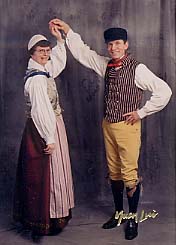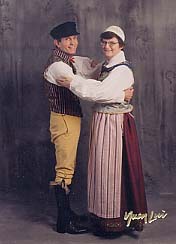 Scandinavian
Folkdance and Folkmusic
Scandinavian
Folkdance and Folkmusic

Skandia Folkdance Society has been
promoting the culture and traditions of Scandinavian Folkdance in Seattle,
Washington, for over 50 years. We have been members for a relatively few
years, but enjoy the classes, workshops and twice-monthly dance parties.
See what Skandia has to offer you by visiting their wonderful website, authored
and maintained by a wonderful member, Dale Abraham. Here is the address
for your convenience: http://www.skandia-folkdance.org
Don't forget to visit the pages describing the
Swedish "dräkt" worn by the Carlsons. It is from the Swedish
province of Blekinge.

THE CLOTHING, MUSIC AND DANCE
Click on either photo to learn more about the "folkdräkt"
seen here
Scandinavia
is
defined as "the region of NW Europe occupied by Sweden, Norway and Denmark,
sometimes including Finland, Iceland and the Faroe Islands". Folk
music and dance in all of these countries has existed for thousands of
years.
(back to the top)
The Music Archaeologists have
found a number of musical instruments, including bronze horns with
an approximate age of 3,000 years, which can be seen in on of the many
museums in Copenhagen, Denmark. The horns have even been replicated
and "played", although the sound they produced in prehistory is not known.
Bone flutes
2,000 years old have descendants which now create music in the same
fashion, but are made of wood. Cow and ram horns from the Viking
period (approximately 1200 years ago) have been found, and they presumably
produced music of some sort. Since the source is so easily accessible,
these ancient horns also have present day descendants.
Of course, the
human voice has always been used as an instrument! Violins, nyckelharpor,
bagpipes of many sizes and shapes, lures and jews harp are but a few of
the "folk" variety of instruments extant in Scandinavia today. Who
knows what instruments have been lost forever in prehistory?!
The Devil's in the Music!
Those of us who think Scandinavian folk
dance and folk music gives us a taste of heaven, often forget that folk
music, musicians and dancers were originally often considered part of another
contingent. The music was so mesmerizing, that many in history have
said that fiddlers had been taught to play by the Devil. Folktales
tell of that special musician who played so beautifully that the chairs
and tables danced, and the dancers danced themselves to death (either by
drowning, or dancing their feet off and disappearing into Devil's Mountain).
During the last half of the 1800s,
a religious revival cast new aspersions on the fiddle. Many fiddles
were smashed, and as one report says, "in some areas the instrumental folk
music tradition was exterminated".
For More Information (many in
Scandinavian languages):
 Folknorth
(sources from all the Scandinavian countries): http://www.folknorth.org/index.html
Folknorth
(sources from all the Scandinavian countries): http://www.folknorth.org/index.html
 Tunes
from Dalarna, Sweden (click on the flute): http://w1.859.telia.com/~u85903393/
Tunes
from Dalarna, Sweden (click on the flute): http://w1.859.telia.com/~u85903393/
 Swedish
"Ungdomsringen": http://www.ungdomsringen.se/
Swedish
"Ungdomsringen": http://www.ungdomsringen.se/
 American
Nyckelharpa Association: http://www.nyckelharpa.org/
American
Nyckelharpa Association: http://www.nyckelharpa.org/
 Northside
(North American/Scandic music--traditional and not): http://www.noside.com/
Northside
(North American/Scandic music--traditional and not): http://www.noside.com/
 Folkmusic
House in Rättvik, Sweden: http://www.folkmusikenshus.w.se/
Folkmusic
House in Rättvik, Sweden: http://www.folkmusikenshus.w.se/
 Danish Folk
Music Socity: http://www.folketshus.dk/folketshus/spillefolk/
Danish Folk
Music Socity: http://www.folketshus.dk/folketshus/spillefolk/
 Norwegian
Folk Music: http://home.online.no/~a-haugen/
Norwegian
Folk Music: http://home.online.no/~a-haugen/
 Rättviksdansen:
http://www.folklore.se/
Rättviksdansen:
http://www.folklore.se/
(back to the top)
The Dances
The Original?
Scandinavian dancing probably began thousands
of years ago with the "long dance". These still persist in great
variety and length, in Iceland. The traditional accompaniment for
such a dance is singing, and in Iceland, the verses upon verses tell a
story.
Apparently these "long" dances included,
or were transformed into "ring" dances, remnants of which can be seen in
the Swedish "ringlekar" (literally circle play), which herald many special
holidays, most particularly at midsommar and at Christmas.
Some of the traditional Christmas
dances are combinations of "long" and "ring" dances. "Nu är
det jul igen" (Now it's Christmas again) is sung as a long dance, charging
through the house, singing, as if to wake all the inhabitants, and
the house itself, to the fact that Christmas has finally arrived!
Of course, the dances around the Christmas tree are "ring" dances honoring
the tree--a very Nordic thing to do.
Midsommar (solstice celebration) is
also cause for wonderful "ring" and "long" dances. Children are the
most enthusiastic participants, but everyone who can walk joins in.
Even the babies who are too young to walk, are held by their parents, as
they "dance to the greenery-clad pole".
Pols, Polka or Polska?
While it seems the most favorite, and
probably the second oldest, of the Scandinavian social/couple dances is
the polska. The uninitiated often confuse this dance with
polka,
which arrived much later in Scandinavia than did the polska.
There are many variations of the polska, but the oldest seems to be the
eighth-note polska, in which the first and third beats are heavily accented,
and the second beat is very long. Polskor from the province of Dalarna
in Sweden, are probably the best known of the polskor. Bingsjö,
Rättvik and Boda, along with Malung and Orsa, each have their own,
distinct polska. As late as the 19th century, it appears some of
the more intricate polskor were transformed into a simpler one--the hambo.
"Slängpolska", on the
other hand, is a sixteenth-note polska, in which the rhythm is extremely
even. The"slängpolska" apparently was a response to the influence
of the polonaise. There are slängpolskor from the southern portions
of Sweden (Småland especially) and a very different slängpolska
exists in the north of Sweden.
Pols is a special Norwegian
type of polska, usually danced with faster music and a deeper svikt (bending
of the knees, ankles and hips) during its execution. The pols from
Røros, in Norway, is probably the best known pols.
The polka arrived in Scandinavia
after the introduction of the quadrille, the waltz and the
mazurka
in the late 18th and 19th centuries. The polka seems to have fathered
the Swedish version, entitled schottis (schotish).
Apparently the Scandinavian folkdance
purists do not consider anything except the polska and pols to be true
and genuine folk music.
For More Information (many in
Scandinavian languages):
 Ringlekar from
Skansen, Sweden: http://www.lysator.liu.se/runeberg/ringleka/
Ringlekar from
Skansen, Sweden: http://www.lysator.liu.se/runeberg/ringleka/
 Skandia Folkdance
Society (Seattle, Washington): http://www.skandia-folkdance.org/
Skandia Folkdance
Society (Seattle, Washington): http://www.skandia-folkdance.org/
 British Columbia,
Canada, Dancers: http://www.vcn.bc.ca/scandi/
British Columbia,
Canada, Dancers: http://www.vcn.bc.ca/scandi/
 D.C. Dancers:
http://users.erols.com/s526/
D.C. Dancers:
http://users.erols.com/s526/
 Musik vid
Siljan (Music at Siljan, Sweden): http://www.musikvidsiljan.se/
Musik vid
Siljan (Music at Siljan, Sweden): http://www.musikvidsiljan.se/
 Rättviksdansen:
http://www.folklore.se/
Rättviksdansen:
http://www.folklore.se/

Visit the Skandia Folkdance
Society official website at http://www.skandia-folkdance.org
for more information.




![]() Rättviksdansen:
http://www.folklore.se/
Rättviksdansen:
http://www.folklore.se/
![]() Rättviksdansen:
http://www.folklore.se/
Rättviksdansen:
http://www.folklore.se/
